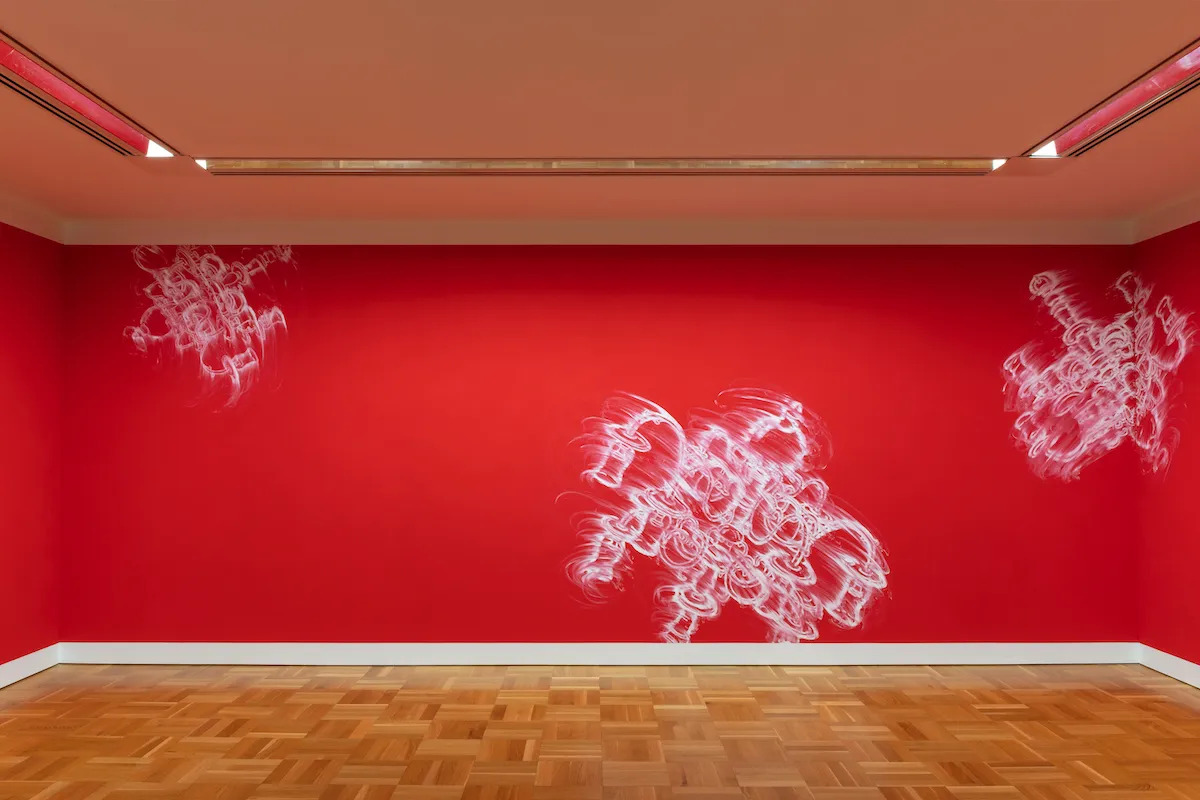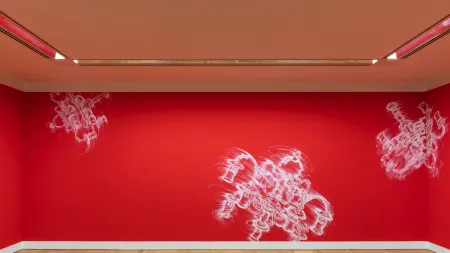
Gary Simmons started off his path to becoming an artist by surreptitiously drawing on a section of the wall behind the couch. After his mother found his hidden drawings, she wondered what Simmons’ father would say. In the end they decided on a compromise: make art on paper or canvas, just not the wall.
“They gave me support in a way that is unusual, especially as a first-generation West Indian kid, in Queens, New York,” Simmons recounted during a lecture to celebrate the opening of his career-spanning show at the Pérez Art Museum Miami, where it is now on view after first appearing at the Museum of Contemporary Art Chicago.
Simmons continued to draw into his young adulthood. Sensing that this was becoming more than a passion project, Simmons’s father asked him if he was prepared to live hand to mouth to pursue his dream of becoming an artist. When Simmons said he was, his father gave him his blessing.
It ended up being worth it. Simmons received his BFA from the School of Visual Arts in 1988, then his MFA from CalArts in 1990, and he has gone on to show work at the Museum of Modern Art and the Venice Biennale. Now, he is having one of his biggest surveys to date.
The first works on view highlight Simmons’ engagement with the burgeoning genre of hip-hop. In the early 1990s, Simmons created a series of photo backdrops that he staged around New York City with references to Public Enemy’s crosshair logo and album covers like the one for Dr. Dre’s The Chronic. Simmons offered to take Polaroid pictures of people walking past, then exhibited the results as a mural. These pieces are about remixing: Simmons credits DJs and hip-hop groups like Terminator X and Public Enemy for inspiring his tendency to cut up existing cultural symbols. And in a sense, the piece, now on view at PAMM, is getting remixed again: audiences are encouraged to take their own pictures in front of these works.
In his lecture, Simmons recounted that when hip-hop hit, it was evident how he’d have to respond. “I knew that I had to find a way to take images that I was into,” he said, “and infuse them and mix them the way that [DJ Terminator] X was mixing music.”

His art of the ’90s displays a keen eye for how symbols travel through the world, erasing and re-forming people in their wake. Empty shoes, vacant boxing rings, and abandoned boxing gloves recur throughout these works, providing commentary on the double-edged sword of Black excellence in the realm of sports. Black bodies are put on display, leading to fame for athletes, yet they are also rendered fragile amid all the spectacle.
“What’s amazing is how timely this is,” said René Morales, chief curator at PAMM and organizer of the Simmons show. He pointed out that this is all particularly topical in Florida, where Governor Ron DeSantis has spoken out against anything even remotely tied to critical race theory in an attempt to curry favor with the MAGA set.
Specifically, Morales was referencing Simmons’s images of classrooms. His 1989 sculpture Big Dunce is a tall white conical hat that recalls the KKK hood; it is shown sitting on a low stool that would be more often seen in a pre-school. And in Six-X (1989), Simmons exhibited clan costumes made to fit kindergartners.
But perhaps his most effective works of this kind are his chalkboard drawings that depict Black caricatures from cartoons Simmons grew up with, like Dumbo and Little Ol’ Bosko and the Pirates. The characters—who are sometimes only partially visible, so that all that’s left behind is a mouth—are sketched in chalk before Simmons smears them with his hands. Chalkboards denote teaching, but there are no obvious lessons to be learned from a fictional figure seen on TV. Yet in his art, Simmons suggests that these racist images do count as a kind of education—just not the one most people would want. He half-erases them in an attempt to unlearn some of what network television is teaching without wiping the slate clean altogether.

“It’s tough material—it’s difficult to look at,” Morales said. “There’s a valid argument to be made that we should just try to stop looking at this stuff and stop letting it continue to harm. But I think, Gary, what your work says is that that’s very dangerous. If you erase, you forget. If you don’t archive these painful memories, as painful and hurtful as it is to look at them again, it’ll all just happen again.”
Of course, we’re far from breaking cycles of racialized abuse in this country. After a decades long hiatus from drawing Black caricatures, Simmons began depicting them again in 2021, in the wake of George Floyd’s death. The last time Simmons made works like these, Rodney King had been brutally beaten by cops.
This new engagement sees the characters taking on more active roles. In works like Rogue Wave (2021), cartoon characters attempt to navigate boats through choppy waters. Are racialized bodies ever done battling the tides? Simmons keeps on asking himself that question.
Activists Call for Ceasefire in Gaza During Protest Outside Art Basel Miami Beach
One Year On From the NFT Crash, the Digital Art Scene at Miami Art Week Matures

Car of the Week: This 1957 Lincoln Restomod Is One of the Most Elegant Low-Riders We’ve Seen, and It’s up for Grabs

Kith to Open Women’s Store, Names Women’s Creative Director

Apple stores to start Vision Pro training soon, but that’s not great news to me

Why Vegas Was the Ideal Host for NBA In-Season Tournament Finals


